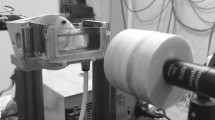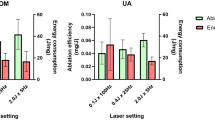Abstract
Purpose
To evaluate whether stone dust can be obtained from all prevailing stone composition types using the thulium fiber laser (TFL) for lithotripsy. Where applicable, stone dust was further characterized by morpho-constitutional analysis.
Methods
Human urinary stones were submitted to in vitro lithotripsy using a FiberLase U2 TFL generator with 150 µm silica core fibers (IPG Photonics®, IPG Medical™, Marlborough, MA, USA). Laser settings were 0.05 J, 320 Hz and 200 μs. A total of 2400 J were delivered to each stone composition type. All evaluated stones had a > 90% degree of purity (calcium oxalate monohydrate, calcium oxalate dihydrate, uric acid, carbapatite, struvite, brushite and cystine). Spontaneously floating stone particles were considered as stone dust and collected for analysis by scanning electron microscopy and Fourier transform infrared spectroscopy.
Results
Stone dust could be retrieved from all evaluated urinary stones after TFL lithotripsy. Most stone dust samples revealed changes in crystalline organization, except for calcium oxalate monohydrate and carbapatite, which conserved their initial characteristics. Mean maximal width of stone dust particles did not exceed 254 µm.
Conclusions
The TFL is capable to produce stone dust from all prevailing stone types. Morpho-constitutional changes found in stone dust suggest a photothermal interaction of laser energy with the stone matrix during TFL lithotripsy.



Similar content being viewed by others
References
Hesse A, Brändle E, Wilbert D, Köhrmann KU, Alken P (2000) Study on the prevalence and incidence of urolithiasis in Germany comparing the years 1979 vs 2000. Eur Urol 44(6):709–713. https://doi.org/10.1016/s0302-2838(03)00415-9
Romero V, Akpinar H, Assimos DG (2010) Kidney stones: a global picture of prevalence, incidence, and associated risk factors. Rev Urol 12(2–3):e86–96
Raheem OA, Khandwala YS, Sur RL, Ghani KR, Denstedt JD (2017) Burden of urolithiasis: trends in prevalence, treatments, and costs. Eur Urol Focus 3(1):18–26. https://doi.org/10.1016/j.euf.2017.04.001
Geraghty RM, Jones P, Somani BK (2017) Worldwide trends of urinary stone disease treatment over the last two decades: a systematic review. J Endourol 31(6):547–556. https://doi.org/10.1089/end.2016.0895
Doizi S, Keller EX, De Coninck V, Traxer O (2018) Dusting technique for lithotripsy: what does it mean? Nat Rev Urol. https://doi.org/10.1038/s41585-018-0042-9
Wenzel M, Bultitude M, Salem J (2019) Dusting, fragmenting, popcorning or dustmenting? Curr Opin Urol 29(2):108–112. https://doi.org/10.1097/MOU.0000000000000580
Dauw CA, Simeon L, Alruwaily AF, Sanguedolce F, Hollingsworth JM, Roberts WW, Faerber GJ, Wolf JS Jr, Ghani KR (2015) Contemporary practice patterns of flexible ureteroscopy for treating renal stones: results of a worldwide survey. J Endourol 29(11):1221–1230. https://doi.org/10.1089/end.2015.0260
Weiss B, Shah O (2016) Evaluation of dusting versus basketing—can new technologies improve stone-free rates? Nat Rev Urol 13(12):726–733. https://doi.org/10.1038/nrurol.2016.172
Traxer O, Keller EX (2019) Thulium fiber laser the new player for kidney stone treatment? A comparison with Holmium: YAG laser. World J Urol. https://doi.org/10.1007/s00345-019-02654-5
Kronenberg P, Traxer O (2019) The laser of the future: reality and expectations about the new thulium fiber laser—a systematic review. Transl Androl Urol 8(S4):S398–S417. https://doi.org/10.21037/tau.2019.08.01
Fried NM (2018) Recent advances in infrared laser lithotripsy. Biomed Opt Express. https://doi.org/10.1364/boe.9.004552
Keller EX, de Coninck V, Audouin M, Doizi S, Bazin D, Daudon M, Traxer O (2019) Fragments and dust after Holmium laser lithotripsy with or without "Moses technology": how are they different? J Biophotonics 12(4):e201800227. https://doi.org/10.1002/jbio.201800227
Lee JW, Park MG, Cho SY (2018) How to perform the dusting technique for calcium oxalate stone phantoms during Ho: YAG laser lithotripsy. BMC Urol 18(1):103. https://doi.org/10.1186/s12894-018-0417-5
Spore SS, Teichman JM, Corbin NS, Champion PC, Williamson EA, Glickman RD (1999) Holmium: YAG lithotripsy: optimal power settings. J Endourol 13(8):559–566. https://doi.org/10.1089/end.1999.13.559
Chan KF, Pfefer TJ, Teichman JM, Welch AJ (2001) A perspective on laser lithotripsy: the fragmentation processes. J Endourol 15(3):257–273. https://doi.org/10.1089/089277901750161737
Vassar GJ, Chan KF, Teichman JM, Glickman RD, Weintraub ST, Pfefer TJ, Welch AJ (1999) Holmium: YAG lithotripsy: photothermal mechanism. J Endourol 13(3):181–190. https://doi.org/10.1089/end.1999.13.181
Ray ER, Rumsby G, Smith RD (2016) Biochemical composition of urolithiasis from stone dust—a matched-pair analysis. BJU Int 118(4):618–624. https://doi.org/10.1111/bju.13448
Daudon M, Dessombz A, Frochot V, Letavernier E, Haymann J-P, Jungers P, Bazin D (2016) Comprehensive morpho-constitutional analysis of urinary stones improves etiological diagnosis and therapeutic strategy of nephrolithiasis. C R Chim 19(11–12):1470–1491. https://doi.org/10.1016/j.crci.2016.05.008
Daudon M, Jungers P (2012) Stone composition and morphology: a window on etiology. In: Talati JJTH, Albala DM, Ye Z (eds) Urolithiasis: basic science and clinical practice. Springer, London, pp 113–140. https://doi.org/10.1007/978-1-4471-4387-1_15
Hardy LA, Vinnichenko V, Fried NM (2019) High power holmium: YAG versus thulium fiber laser treatment of kidney stones in dusting mode: ablation rate and fragment size studies. Lasers Surg Med 51(6):522–530. https://doi.org/10.1002/lsm.23057
Keller EX, De Coninck V, Doizi S, Daudon M, Traxer O (2020) What is the exact definition of stone dust? An in vitro evaluation. World J Urol. https://doi.org/10.1007/s00345-020-03178-z
Acknowledgements
We wish to thank Prof. Dominique Bazin, PhD, Research Director at the French National Centre for Scientific Research (CNRS) in Orsay, France, for scanning electron microscopy assistance.
Funding
None.
Author information
Authors and Affiliations
Contributions
EXK: protocol/project development, data collection or management, data analysis, and manuscript writing/editing. VDC: protocol/project development, data analysis and manuscript writing/editing. SD: data analysis and manuscript writing/editing. MD: protocol/project development, data collection or management, data analysis and manuscript writing/editing. OT: protocol/project development, data analysis and manuscript writing/editing.
Corresponding author
Ethics declarations
Conflict of interest
Dr. Etienne Xavier Keller is a consultant for Olympus, Debiopharm and Recordati. Dr. Vincent De Coninck is a consultant for Boston Scientific, BD Bard and Coloplast. Dr. Steeve Doizi is a consultant for Coloplast and Boston Scientific. Prof. Michel Daudon, PhD, is a consultant for Advicenne. Prof. Olivier Traxer is a consultant for Coloplast, Rocamed, Olympus, EMS, Boston Scientific and IPG Medical.
Ethical approval
All procedures performed in studies involving human participants were in accordance with the ethical standards of the institutional and/or national research committee and with the 1964 Helsinki declaration and its later amendments or comparable ethical standards.
Additional information
Publisher's Note
Springer Nature remains neutral with regard to jurisdictional claims in published maps and institutional affiliations.
Rights and permissions
About this article
Cite this article
Keller, E.X., De Coninck, V., Doizi, S. et al. Thulium fiber laser: ready to dust all urinary stone composition types?. World J Urol 39, 1693–1698 (2021). https://doi.org/10.1007/s00345-020-03217-9
Received:
Accepted:
Published:
Issue Date:
DOI: https://doi.org/10.1007/s00345-020-03217-9




